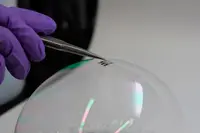 Researchers at MIT have demonstrated what they claim are the thinnest, lightest solar cells ever produced. This proof-of-concept shows an approach to making solar cells that could help power the next generation of portable electronic devices.
Researchers at MIT have demonstrated what they claim are the thinnest, lightest solar cells ever produced. This proof-of-concept shows an approach to making solar cells that could help power the next generation of portable electronic devices.
According to the researchers, the key to their approach is to make the solar cell, the substrate that supports it, and a protective overcoating to shield it from the environment, all in one process. The substrate is made in place and never needs to be handled, cleaned, or removed from the vacuum during fabrication, minimising exposure to dust or other contaminants that could degrade the cell’s performance.
Professor Vladimir Bulovic, MIT’s associate dean for innovation, said: “The innovative step is the realisation that you can grow the substrate at the same time as you grow the device.”
In this experiment, the team used a common flexible polymer called parylene as both the substrate and the overcoating, and an organic material called DBP as the primary light-absorbing layer. The entire process takes place in a vacuum chamber at room temperature and without the use of any solvents, unlike conventional solar-cell manufacturing, which requires high temperatures and harsh chemicals. In this case, both the substrate and the solar cell are ‘grown’ using established vapour deposition techniques.
To demonstrate just how thin and lightweight the cells are, the researchers placed a working cell on a soap bubble without popping the bubble. The researchers acknowledge that this cell may be too thin to be practical, but parylene films of thicknesses of up to 80µm can be deposited using commercial equipment, without losing the other benefits of in-line substrate formation.
While the solar cell in this demonstration device is not especially efficient, because of its low weight, its power-to-weight ratio is claimed to be among the highest ever achieved. This is significant for applications where weight is important, such as on spacecraft or on high-altitude helium balloons used for research. Whereas a typical silicon-based solar module, whose weight is dominated by a glass cover, may produce about 15W of power per kilogram of weight, the MIT team says its cells have demonstrated an output of 6W per gram - around 400 times higher.
“It could be so light that you don’t even know it’s there, on your shirt or on your notebook,” said Prof Bulovic. “These cells could simply be an add-on to existing structures.”
The team says that developing these cells into a manufacturable product will take time. Yet while commercial success in the short term may be uncertain, this work could open up new applications for solar power in the long term.
Pic: To demonstrate just how thin and lightweight the cells are, the researchers draped a working cell on top of a soap bubble, without popping the bubble.
Author
Tom Austin-Morgan
Source: www.newelectronics.co.uk
